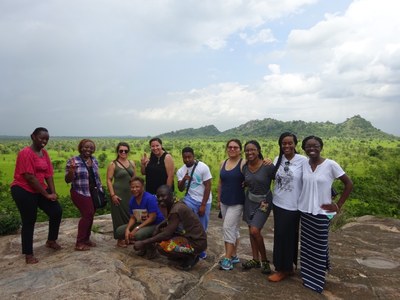SPHIS Home » News » Ghana-Sankofa Experience
Ghana-Sankofa Experience
Author: Chandler Hawkins, SPHIS Student, June 2017

In elementary school, teachers are involved in every aspect of a student’s learning. They teach every subject, reading, writing, mathematics, etc. Then middle school finds the teachers less involved. Kids switch classes throughout the day, and teachers only teach one or two subjects. In high school, teachers do the same, but at this point those pre-teens have become teens and do not require their hands to be held through class.
In college, there are professors or lecturers. There are some that differentiate themselves by allowing students to learn through life experiences and research. Professors like Dr. Muriel Harris and Trinidad Jackson, accompanying eight students to Ghana for 21 days. Dr. Harris and Trinidad became tour guides, travel agents, emergency responders, chaperones, photographers and whatever else a college student needed to make their time in a host country memorable, educational, comfortable and most importantly fun.
As we began our journey, we did not know what to expect, but we were excited about what the experience could bring to our lives. On May 16th, 2017, eight students from the School of Public Health and Information Sciences, embarked on a journey that we would never forget. We were given the opportunity to embrace the culture and the beautiful people of Ghana, Africa.
We visited Ghana, completed a qualitative research study within the community and immersed ourselves into a new world. Within this qualitative study we traveled to the city of Obuasi, home to one of the four major gold mines in Ghana. We facilitated and completed a photo voice project that entailed asking community members to take pictures of things around them that affected their health and interviewing them. Through these interviews, we gained a better understanding of the public health issues within the population.
During our trip, we traveled to the capital of Ghana, Accra, the city of Kumasi and many more. Throughout our three weeks in Ghana, we were also afforded the opportunity to partake in amazing excursions such as the hanging bridges in the Kakum National Forest, The Cedi Bead Factory and Tafi Atome Monkey Sanctuary.
In addition to breathtaking excursions, we were taken to educational monuments that reflected the history of Ghana, civil rights and Pan-Africanism. These monuments included Independence Park, where advocate for independence Kwame Nkrumah is laid to rest, and the house of civil rights activist W.E.B Du Bois. To fully experience the culture of Ghana we spent sometime in the city of Cape Coast. While there, we visited two slave castles, Cape Coast and Elmina Castle.
It was an unforgettable and chilling experience to stand in the same room where millions of slaves were held. We experienced the cells and the dungeons where human beings were shackled together and forced to sit and sleep in their own waste. Personally, the most memorable element of this tour was walking through the “Door of No Return.” The door in which slaves marched out of the slave castle to the boat that would take them away from their home land.
As I reflect on my time in Ghana, I am reminded of the concept of Sankofa, which means “to go back and get it”. Sankofa teaches us that we must go back to our roots in order to move forward. Whatever we have lost, forgotten or have been stripped of can be reclaimed. This trip to Ghana has opened my eyes to my roots, while also teaching me about myself and my full potential as I move forward. I am thankful for the captivating experience and forever grateful for the opportunity that Dr. Harris has given me and my classmates.






